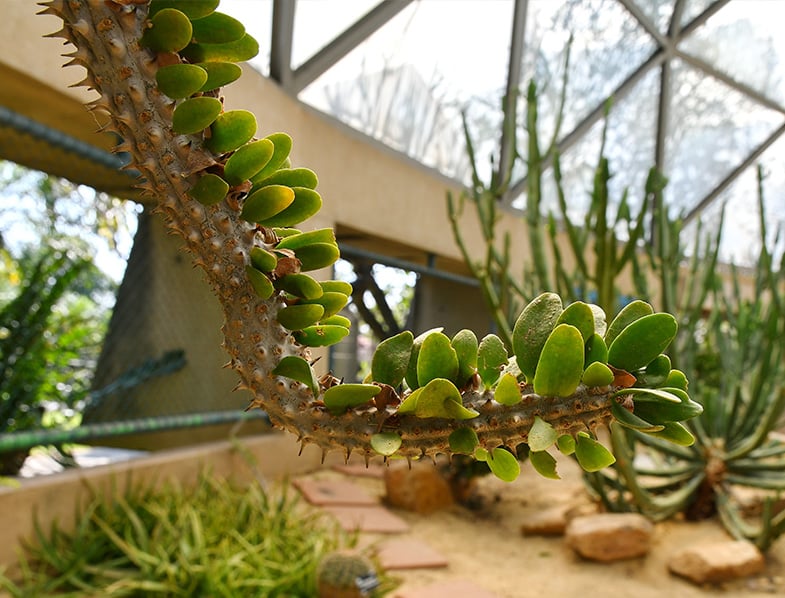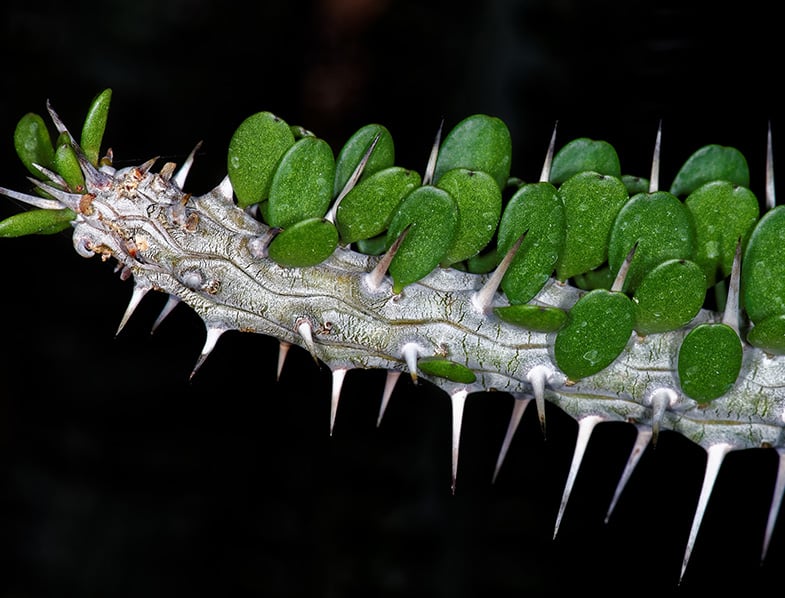Is your garden missing a unique focal point? A Madagascar Ocotillo plant is the perfect solution to your problem! This interesting cactus is not very common and it will surely surprise all of your guests.
Alluaudia Procera, commonly known as Madagascar Ocotillo, is a unique-looking succulent tree. Its peculiar appearance makes it an interesting landscape plant fit for some outdoor gardens and indoor containers. Coming from Madagascar, Alluaudia Procera is a drought-tolerant plant that stores water inside its stems for long periods of drought. For this reason, this succulent is a perfect addition to gardens in arid but frost-free areas.
The good news is that Alluaudia Procera can also be grown in a container as a houseplant. It has pretty much the same basic growing needs as most succulents. So, whether you are a novice or an experienced grower, caring for a Madagascar Ocotillo isn’t going to be too complicated.
Ready to learn more on how to grow and care for an Alluaudia Procera a.k.a. Madagascar Ocotillo? Keep reading our article!

Here is our recommended online shops for purchasing succulents & supplies
 Succulents Box
Succulents BoxSucculents Box currently offers more than 200 varieties of succulents (both popular and rare ones) along with 5 monthly subscription boxes.
Visit Store Leaf & Clay
Leaf & ClayLeaf & Clay offer a range of hundreds of types of succulents along with subscription boxes, pots & macrame.
Visit Store Lula’s Garden
Lula’s GardenLula’s Garden offers a selection of succulent garden gift sets from small single succulents in pots to full succulent gardens.
Visit Store The Succulent Source
The Succulent SourceThe Succulent Source offers a huge selection of succulents, cactii and also gift sets and items for weddings.
Visit Store Planet Desert
Planet DesertPlanet Desert cater to succulent and cactii fans with a large range of plants, soil, kits and other supplies for creating your garden.
Visit Store

About Madagascar Ocotillo
- Madagascar Ocotillo belongs to the family of Didiereaceae, and, as mentioned above, it is Madagascar-native.
- The botanical name of this succulent is Alluaudia Procera, but it is also commonly known as Madagascan Ocotillo, Madagascar Ocotillo, and African Ocotillo.
- Thanks to its attractive and unique appearance, Madagascar Ocotillo is a great succulent for both indoor and outdoor environments that need a focal point. This succulent is commonly grown in pots as a houseplant, but it is also commonly used in larger xeriscape plantings, rock and cactus gardens.
- During the wintertime, Madagascar Ocotillo loses all its leaves. So, don’t worry! Your plant is not dead. It is just time for it to take a rest.
- Since it is very resistant to drought, and it has the same growing requirements as most succulents, Madagascar Ocotillo is really easy to care for.
- Like most succulents, Madagascar Ocotillo loves very sunny spots where it can get direct sunlight. This succulent needs full sun to thrive. So, whether you’re planning to grow your Madagascar Ocotillo indoors or outdoors, make sure you place it in a very bright location.
- Considering that it is native to an area with a subtropical climate, it’s no surprise that Madagascar Ocotillo loves warm temperatures. The minimum temperature it can survive to is 30 °F (-1.1 °C). So, make sure you protect your succulent from freezing temperatures during the cold season.
- Madagascar Ocotillo is very sensitive to overwatering like most succulents are. Since it is a very drought-tolerant plant and it stores water inside its stems for long periods of drought, it’s nearly impossible for this succulent to die because of underwatering. However, it can die if you overwater it.
- Since it is susceptible to overwatering, Alluaudia Procera must be kept in well-draining soil that will allow excess water to pass through it. Root rot is one of the most common problems that can kill this succulent if overwatered. Well-draining soil will protect it from root rot.
- This succulent doesn’t have any known disease problems. Yet, we recommend watching out for sucking insects and scales as these bugs may use the plant as their food source. If you notice any type of pest infestation on your Madagascar Ocotillo, treat it with insecticidal soap.
- Madagascar Ocotillo isn’t known to be toxic to humans or animals. However, the spines of this succulent are very sharp and can be irritating to the skin. Remember to use gloves when planting or handling a Madagascar Ocotillo.

Madagascar Ocotillo Features: An Overview
- Madagascar Ocotillo has a unique appearance. It is a spiny succulent shrub or small tree and can reach up to 60 feet (18m) tall.
- This succulent features long and unbranched stems that are covered with paired, rounded long leaves and grey spines.
- The central stem of Alluaudia Procera has a cylindrical shape and can be free of branches for up to 33 feet (10 m) long.
- Although rarely, Madagascar Ocotillo can produce greenish-yellow tiny male or female flowers. They appear in open thyrses at the tips of the succulent’s branches.
- Madagascar Ocotillo looks very similar to the American Ocotillo with red flowers. Both plants feature small rounded leaves and gray spines. However, the two plants belong to different families. While Madagascar Ocotillo is part of the Didiereaceae family, the American Ocotillo actually belongs to the Fouquieriaceae family.
Growing Madagascar Ocotillo
Despite its unique appearance, which can be a little bit intimidating, caring for Madagascar Ocotillo is not complicated at all. In fact, if you have cared for succulents before, growing a Madagascar Ocotillo is going to be really easy for you. Alluaudia Procera has pretty much the same basic growing requirements most succulents have. Besides that, this succulent is very forgiving and drought-tolerant. So, it’s nearly impossible to kill a Madagascar Ocotillo due to neglect.
First, you need to pay attention to this succulent’s lighting requirements. As we’ve already mentioned, Madagascar Ocotillo loves very sunny spots and needs full sun to thrive. Whether you will be growing your succulent indoors or outdoors, you need to make sure that you place it in a spot where it receives full sun for at least a few hours a day.

Alluaudia procera plant, From Amazon
You should also fertilize your Madagascar Ocotillo if you think it needs some extra nutrients to thrive. We recommend using a fertilizer that is diluted to ¼ the recommended rate on the label.
When it comes to pruning, it is necessary to keep the plant in the desired shape. Keep in mind that this succulent can grow up to 60 feet (18m) long. So, if you grow it in a container or in a small garden, it’s best to control its growth and shape with regular pruning.
How to Plant Madagascar Ocotillo
Planting a Madagascar Ocotillo is just as easy as it is to care for it. All you have to do is to keep its growing needs into consideration when you choose its location. Also, keep in mind that this succulent is very prone to root rot, meaning it will need well-draining soil.
First things first, when deciding on where to plant your Madagascar Ocotillo, remember that it needs to grow in a sunny spot where it receives full sun for the most part of the day.
Next, you also need to keep in mind that this succulent is Madagascar-native and loves warm temperatures. So, depending on the climate of the area you live in, you’ll have to choose between planting it in your garden or in a container and grow it as a houseplant.
More precisely, the lower temperature this succulent can survive to is 30 ° F (-1.1 ° C). If you live in an area with a climate that frequently gets colder than that, your best option is to plant your Madagascar Ocotillo in a pot and grow it indoors (or bring it inside your home during the cold season).
If you live in an area where temperatures are generally warm, you can plant and grow your Madagascar Ocotillo outdoors in your garden as well.
Besides that, remember that Alluaudia Procera is very susceptible to root rot, which is why it needs well-draining soil to eliminate excess water. To create well-draining soil for planting your succulent, use a fast-draining potting soil mix combined with sand or pebbles for improved water drainage.
An important thing to keep in mind! When choosing a location in your garden for your Madagascar Ocotillo, keep in mind that this succulent is covered with sharp spines. So, it’s best to choose a spot away from pedestrian traffic.

Watering Madagascar Ocotillo
Overwatering your Madagascar Ocotillo is the sure way to kill it! This succulent, like most other succulents, hates wet feet and can die due to root rot.
One important thing to keep in mind is never to let your Madagascar Ocotillo sit in pooling water or in moist soil for too long. Pour off any excess water you may have poured into the pot by mistake.
To make sure that you don’t overwater your Alluaudia Procera, use the “soak and dry” watering method. In other words, allow the top few inches of the soil to dry out completely before watering your succulent again.
Important tip! During winter, you should stop watering your succulent until the leaves start to grow again because this is the time of the year when Madagascar Ocotillo is dormant and won’t absorb any water.
Propagating Madagascar Ocotillo
Want more Madagascar Ocotillo plants in your home or garden? We have some great news! It’s really easy to propagate this succulent. Alluaudia Procera can be propagated via stem cuttings and seed.
If you want to propagate your mature Madagascar Ocotillo using stem cuttings, make sure you allow the cutting a few days to heal before replanting it in well-draining soil. After you plant it in soil, you can start caring for it similarly to how you care for your mature succulent.
In Conclusion
Madagascar Ocotillo is a lovely unique succulent that can make a great focal point in any indoor or outdoor environment. Despite its intimidating spiny appearance, it is a forgiving plant that is really easy to care for.
Whether you are a novice or an experienced succulent grower, caring for Alluaudia Procera won’t give you a hard time.
Do you have a Madagascar Ocotillo? Share your experience in the comments below!

3 Comments
This is a great summary. I have a single stalk plant that is now about 2 feet tall. Will it put out additional branches? It seems to just grow longer/taller. Do I need to cut it to foster branches?
Mine grew almost 2m long and I had to give it a stake for support, it threw off 2 more stars almost a foot from the base. They just lean whichever way and grow longer and longer, and I kind’ve lean them against each other. I too, am wanting more info on pruning… like can I just cut all stems short & they will shoot of new growth? Mine is just in a large pot, so I can’t really have it getting 18ft tall lol.
I seen a lot of these plants that are straight up and down and then others that are just wild. I like the up and down version. How do you get it to do that?